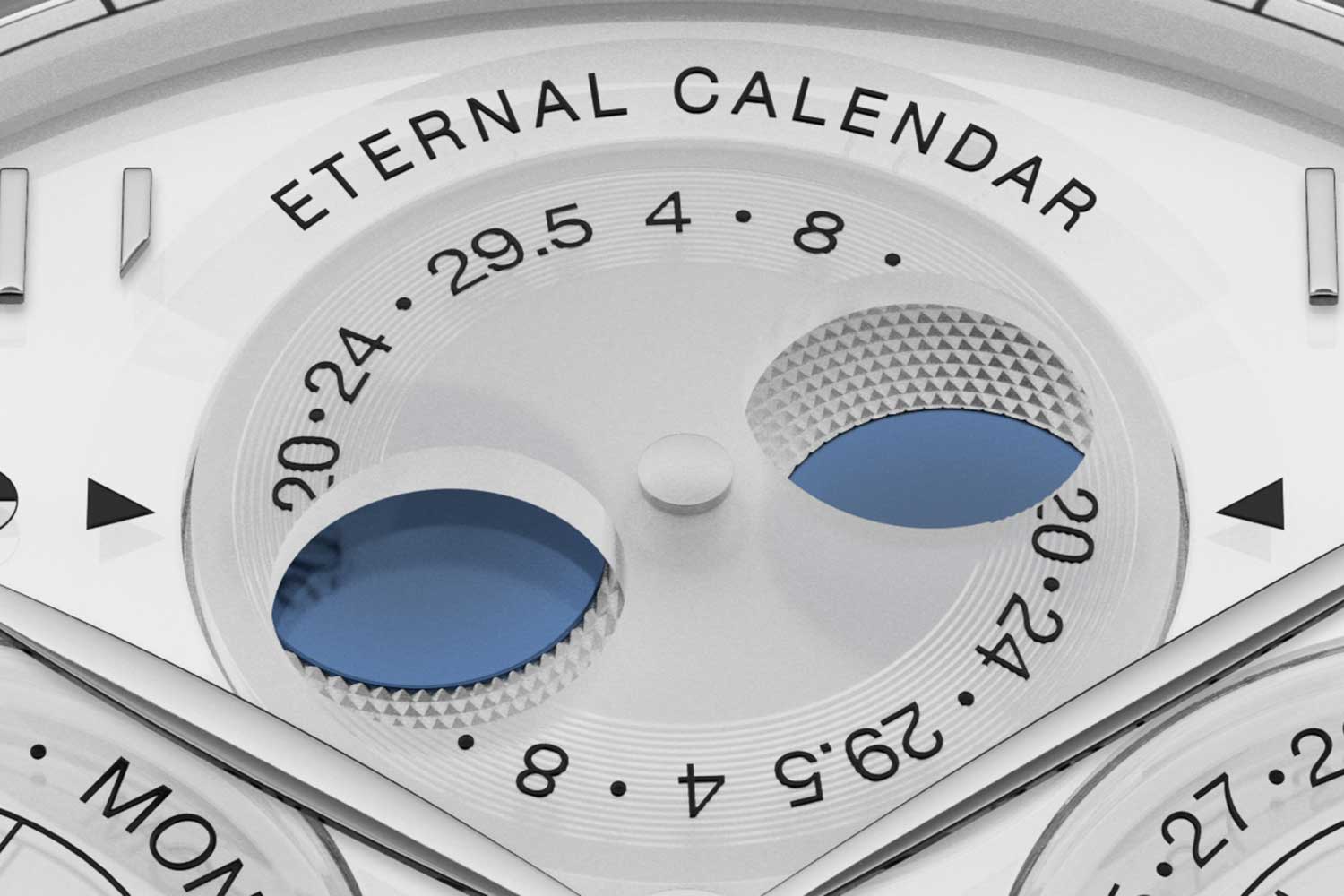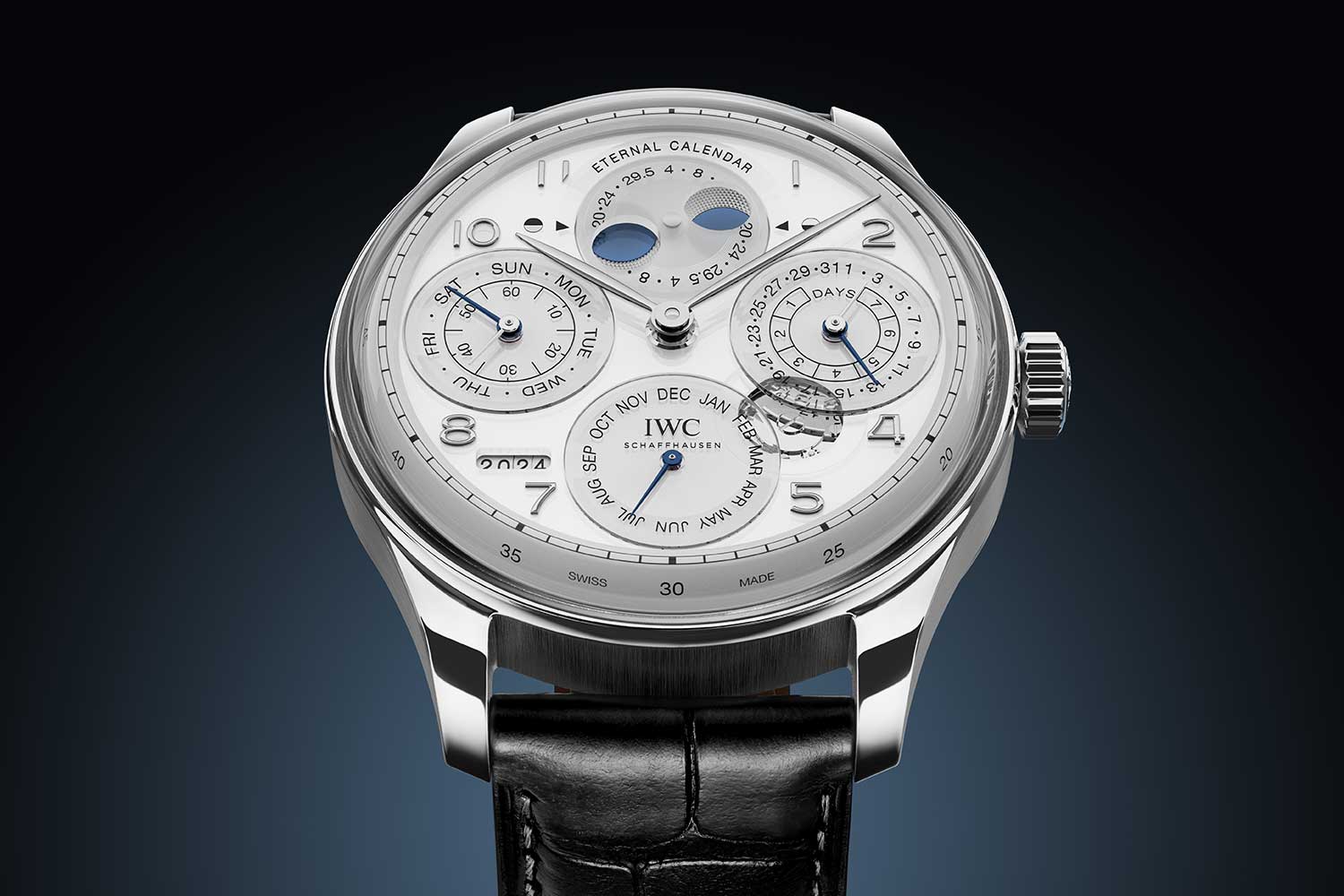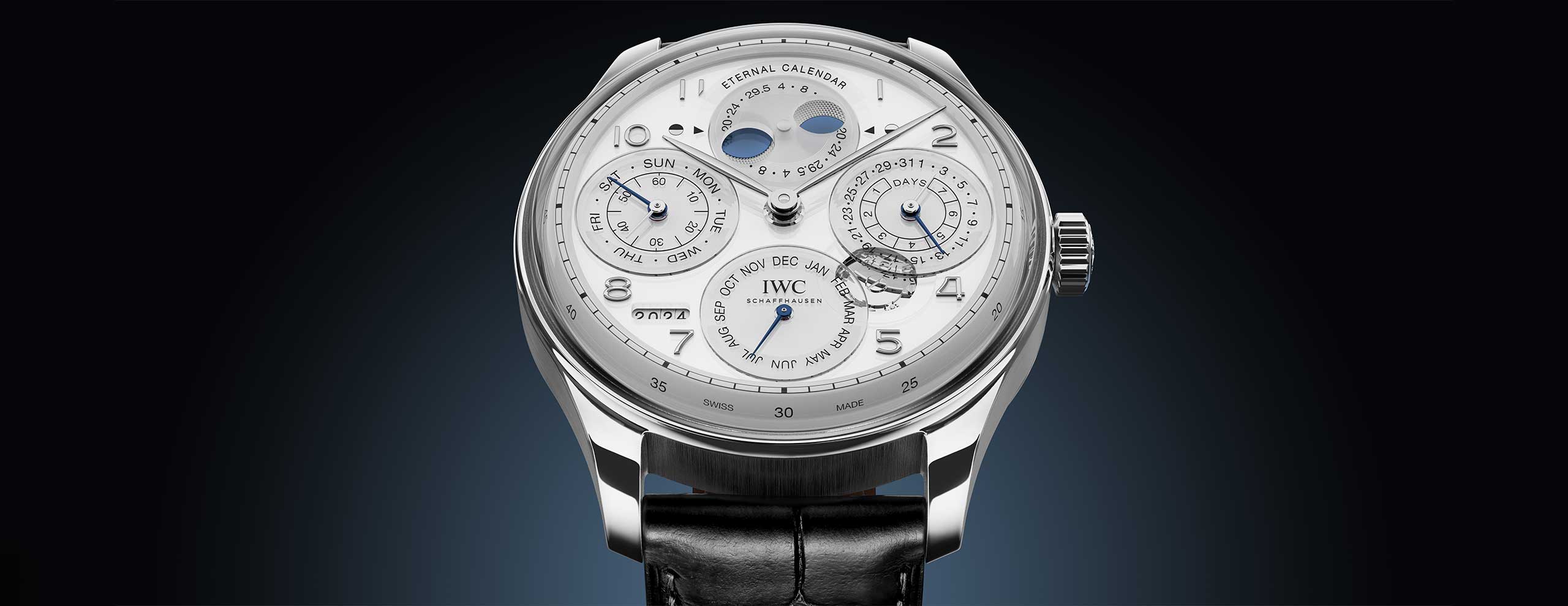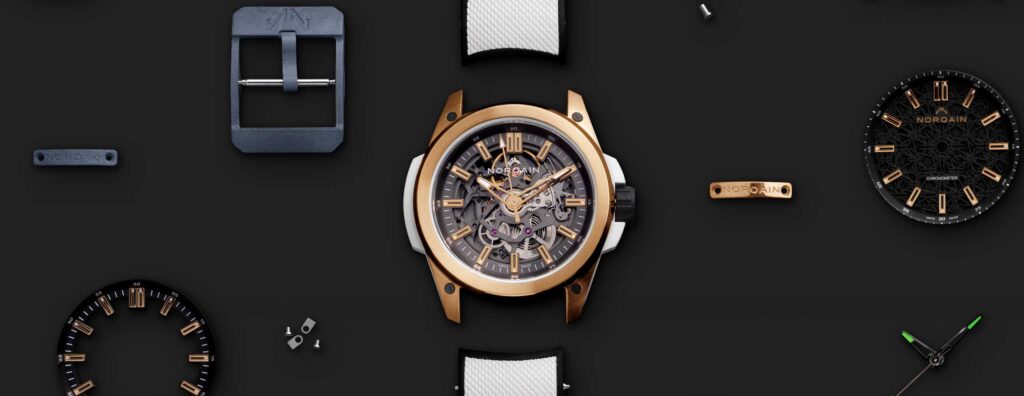The first secular perpetual calendar wristwatch in which all adjustments can be made via the crown and a new record holder of the world’s most accurate moon phase display
One of the most impressive releases at Watches & Wonders this year is the IWC Portugieser Eternal Calendar. It is a secular perpetual calendar which has a 400-year cycle encoded in its gear train, taking into account the common year that occurs at the end of three consecutive centuries while maintaining the leap year in the fourth century. What’s even more intriguing is that the secular calendar ingeniously leverages the foundational design of the renowned perpetual calendar module developed by Kurt Klaus, thus innovating to achieve a 400-year cycle within that framework. As such, the Eternal Calendar inherits the user-friendly design of Klaus’ module in which all calendar indications, including the moon phase, can be adjusted via the crown.
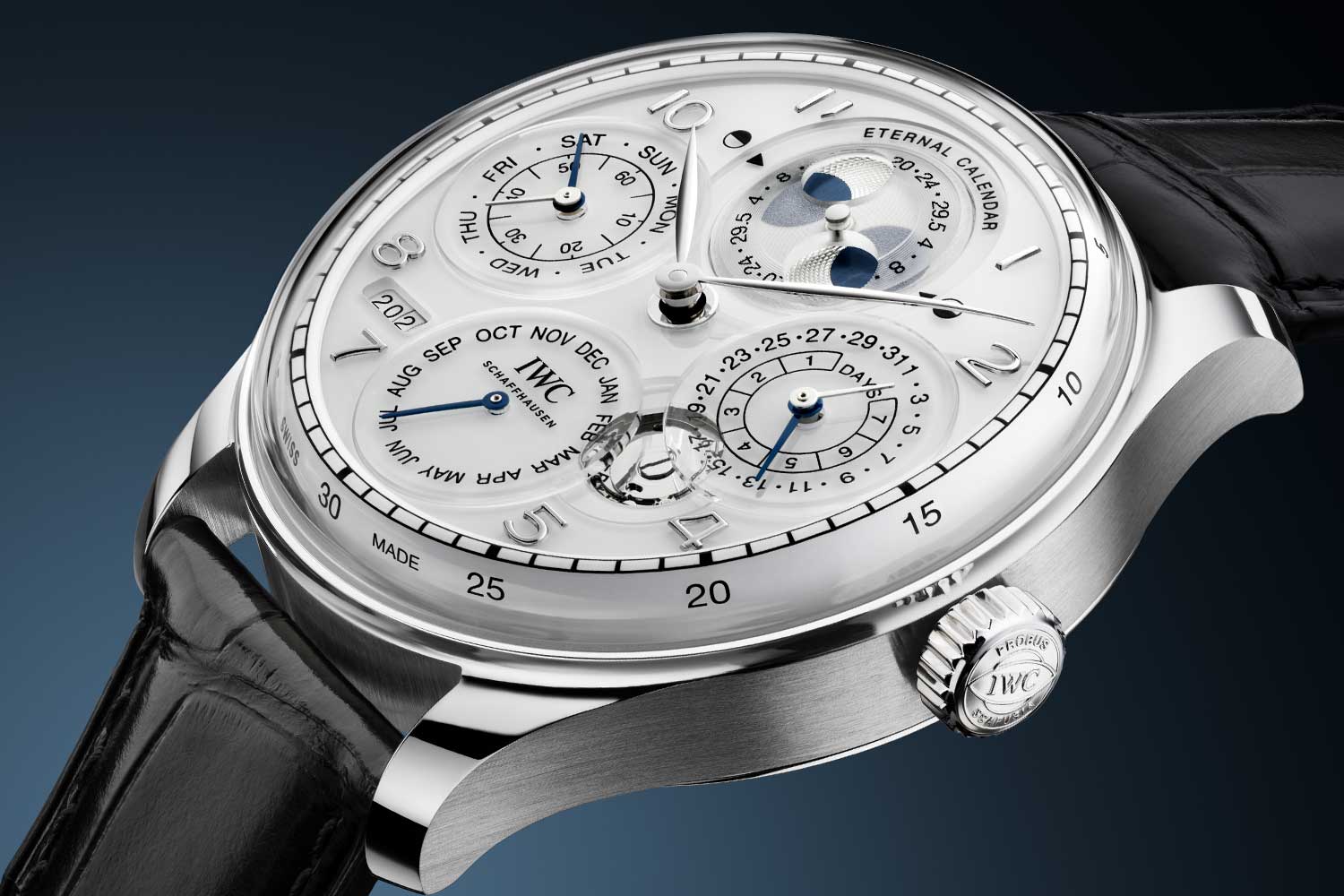
IWC Portugieser Eternal Calendar
Beyond that, the Eternal Calendar shatters the world record held by Andreas Strehler’s Sauterelle à lune perpétuelle over the last decade for the most accurate moon phase display. The moon phase mechanism in the Eternal Calendar accumulates a day of error over an astonishing 45 million years, far surpassing Strehler’s achievement of 2.045 million years.
Speaking to Revolution, Stefan Ihnen, Associate Director of Technics, Research & Design, reveals that both the secular calendar and the moon phase were developed over a span of four years before being integrated into a single timepiece.
The Secular Perpetual Calendar
Secular perpetual calendars are exceptionally rare in watchmaking due to the complexity of having to negate the leap year encoded in the month program wheel (48-month or 12-month cam) every 100 years. Consequently, the unique configuration of the program wheels is often subject to patent protection or kept confidential. While the construction of a traditional perpetual calendar is textbook, each secular perpetual calendar harbor unusual and intriguing solutions that are absolutely unique.
Various approaches have been observed in the design of secular calendars. For instance, the Patek Philippe Calibre 89 utilized a standard 12-month cam with a Maltese cross satellite to manage the month of February and this setup was duplicated in the secular program wheel to account for three consecutive centuries in every four centuries that are non-leap years. This however necessitated a particularly convoluted method of negating the month cam every 100 years, involving a special lever that is uniquely designed and positioned to come into contact with the 400-year Maltese cross satellite instead of the month cam every 100 years.
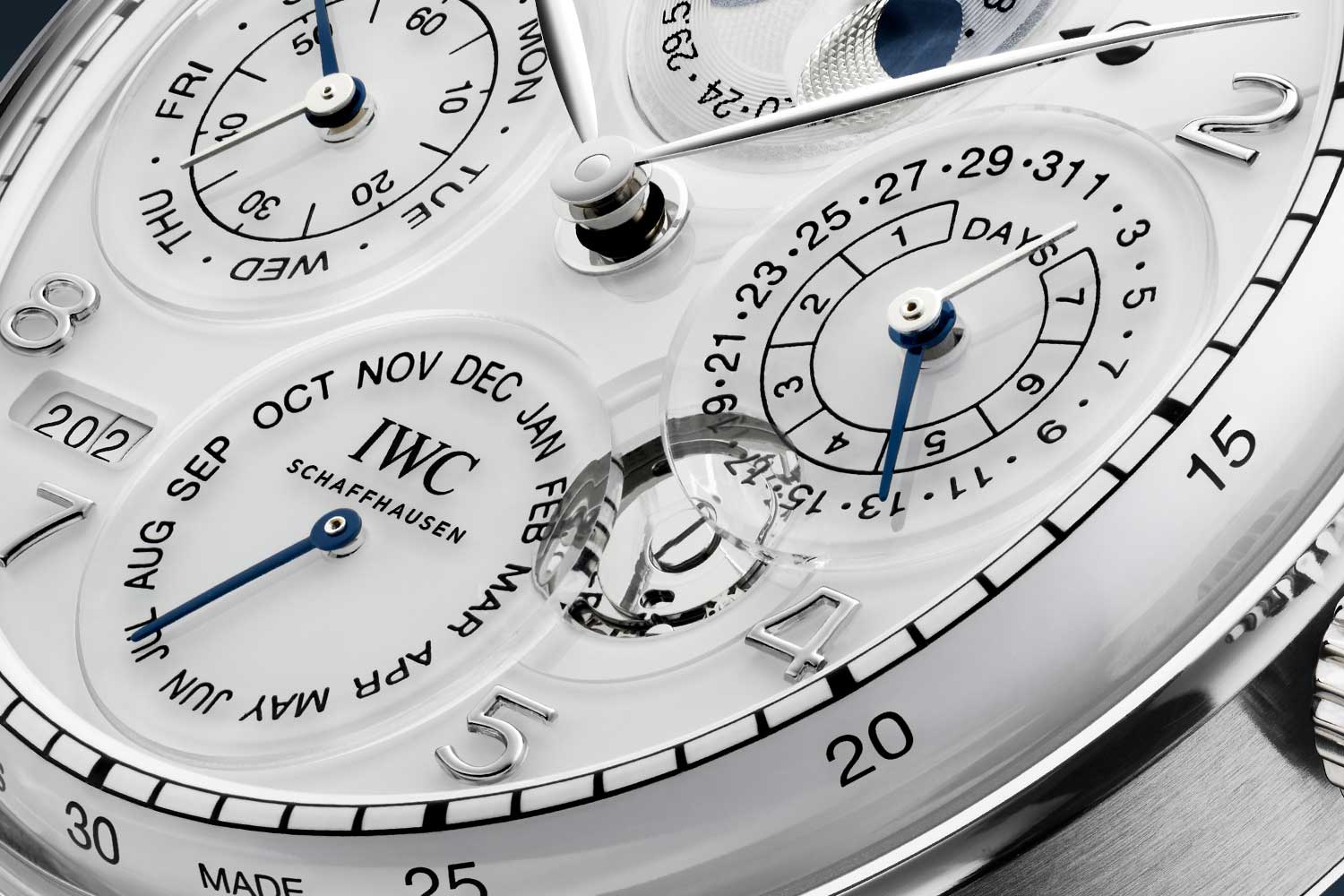
In contrast, the Franck Muller Aeternitas Mega employed a 12-month cam in conjunction with a separate leap-year cam. The 400-year secular cam is designed with three low steps enabling the lever to move back in such a way that the leap year cam is in the same position for a conventional 28-day month of February in three consecutive centuries and then a high step to account for February 29 of the year 2400. It is equally complex, necessitating a long and convoluted train of wheels and a grand lever that has a total of five touch points. More recently, the Furlan Marri introduced a secular perpetual calendar that is wholly innovative in construction in that it is governed by a peripheral rocker while its 48-month cam has four openings for February, enabling the secular mechanism to override the month cam annually rather than every century.
To recap in brief, Kurt Klaus’ perpetual calendar module is characterized by a unique, ring-shaped grand lever that encircles the date wheel and is governed by a 48-month cam program wheel. The grand lever has a feeler arm that samples the 48-month cam while its ring-shaped structure has a shift pawl that advances a 31-tooth date ratchet wheel daily. The secular perpetual calendar retains both the ring-shaped grand lever and the 48-month program wheel.
Technical drawings are unavailable at the moment, but Ihnen has divulged that the secular mechanism is built into this 48-month cam. The 48-month cam is designed with four equally deep notches for the month of February. Every four years, a feeler on the grand lever penetrates the notch and lands on a 400-year cam. This 400-year cam is designed with three notches distributed successively every 90 degrees to take into account the century years that are common years. It either cooperates with the February notch on the 48-month cam or reduces its depth for the insertion of an additional day. This 400-year cam rotates on an eccentric circular path, meaning it moves in a circular path that is offset from the center of rotation. This offset creates a larger effective path enabling it to dictate the length of February every four years. This arrangement is facilitated through a Maltese cross reduction system and the secular module consists of just eight parts in total.
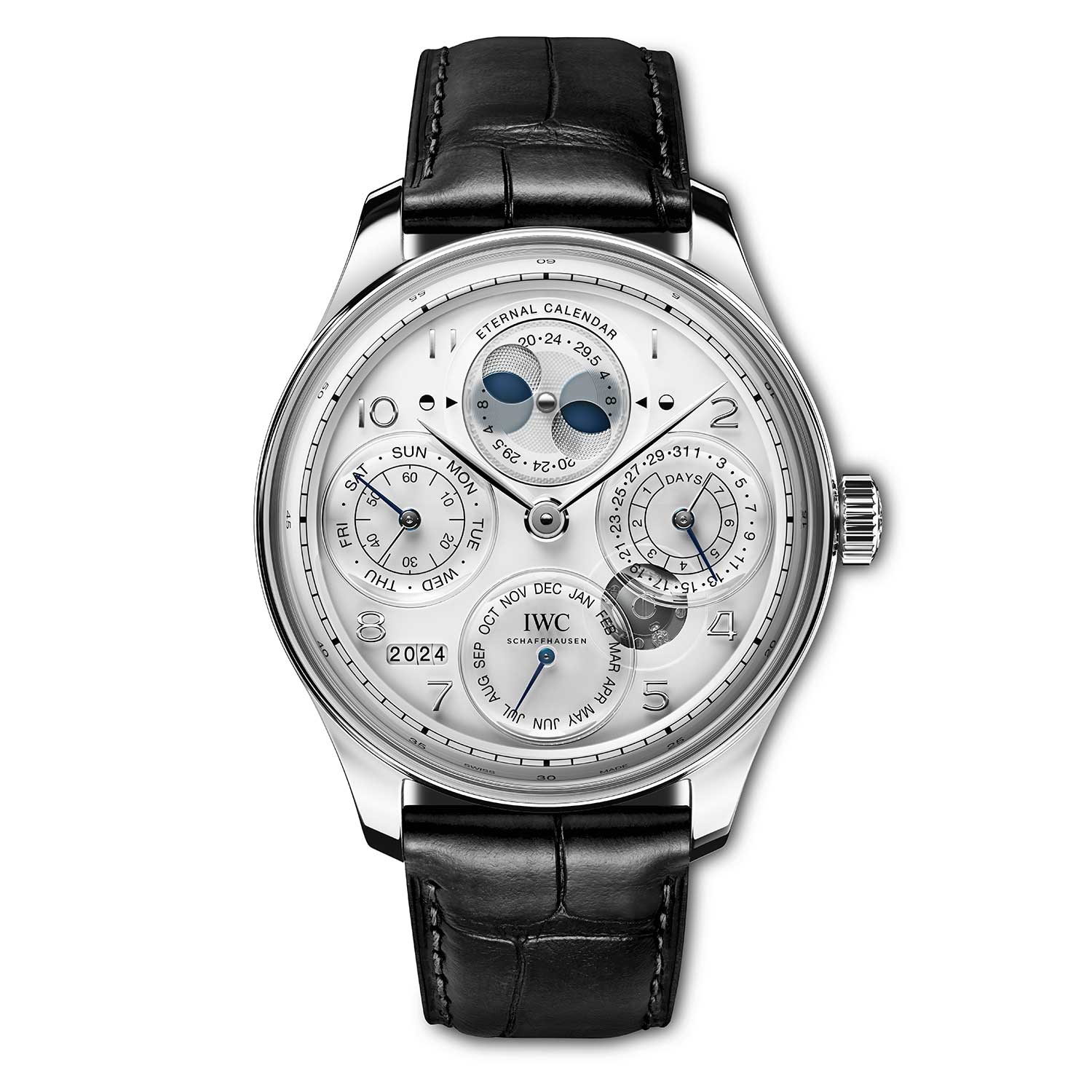
When asked about the number of configurations that were explored before arriving at this solution, Ihnen explains, “We tried three or four variants where we optimized the shape of the Maltese cross and so on, but I think it was pretty straightforward. I have to say as calendars are really one of our core elements in the complicated watches of IWC, we did several trials over the past 15 to 20 years and were thinking about the idea and how to manage this [secular perpetual calendar]. There were also some other mechanisms we developed but mostly they were not producible. We couldn’t minimize them enough. But here with this compact way to integrate the secular mechanism directly into the month program wheel, we found a smart solution to overcome these problems.”
When discussing the solutions employed by the competition, Ihnen noted, “What we have seen from the competition is quite complex and studying them weren’t very helpful as they are very different. Our perpetual calendar is steered only by the crown and the base is completely different, so we had to find our own solution.” Indeed, the admirable thing about the Eternal Calendar is the fact that it was able to be built from Klaus’ module without a wholesale redesign.
A new record breaker in moon phase precision
The mechanics of the calendar might be intelligible, but the moon phase’s precision – accurate to a day in 45 million years – is hard to fathom and evokes a profound sense of smallness in the face of such immense spans of time.
In a basic moon phase complication, a 59-tooth wheel is employed with two moons printed on it. It advances one tooth per day, accumulating a day’s error in just 2.5 years. In the 1980s, Kurt Klaus devised a gear train that would accumulate a day of error in 122 years, setting the industry standard. Modern perpetual calendars from IWC are even more precise, maintaining accuracy to within one day every 577.5 years.
Strehler achieved a moon phase accuracy of a day in 2.045 million years using four wheels, one of which has internal teeth. Ihnen emphasizes that there are just three gears in the Eternal Calendar’s moon phase mechanism, and they are conventional gears. “The magic is not the mechanism itself but in identifying the optimal setup and ratio,” he explains.
“For this, we developed a computer program specifically to solve this problem where we could input all the different parameters such as the number of teeth, available space, diameter of the wheel, the length of a lunar cycle – 29 days, 12 hours, 44 minutes and 2.88 seconds – and then this simulation program did almost 23 trillion calculations of different configurations of gears.” Ihnen continues, “It was not just about precision as we also had to integrate it into the existing perpetual calendar mechanism and optimize the available space. The watch itself is almost the same dimensions as our standard Portugieser Perpetual Calendar.”
“The gears themselves are larger than what we used previously. We really had to respect the available space, considering the constraints imposed by screws and other components. We had to input the appropriate diameter of the wheels and also the maximum number of teeth so that the wheels remain producible” Ihnen continues. “For example, we gave a maximum of 100 teeth for the larger wheels, while for the pinions, we specified a minimum of 7 or 8 teeth. Naturally, we pushed the limits of what is physically possible in terms of tooth size, ensuring that the design remains both producible and robust.”
Fitting for such a significant accomplishment, the Portugieser Eternal Calendar is executed in platinum, the noblest of metals. The case measures 44.4 mm by 15mm. It is indeed just a hair larger than the standard Portugieser Perpetual Calendar, which is 44.2 mm in diameter and 14.9 mm high.
The dial is equally elaborate. It is made of a box sapphire crystal that is frosted and lacquered in white on its underside. The sub-dials are inlays that are made separately and then inserted into the main dial. The numerals, scales and text are then printed on it, and the hour numerals are applied. Additionally, the minute railroad track is printed on a separate white lacquered flange. Finally, the dial is further topped by a box type sapphire crystal.
Movement: Automatic Calibre 52640; power reserve of 168 hours or 7 days; 4Hz or 28,800 vph
Functions: Hours, minutes, small seconds; secular perpetual calendar with four digit year
Case: Platinum; 44.4mm by 15mm; water resistant to 50 meters
Dial: Box sapphire crystal with white lacquer; rhodium-plated hands and appliques
Strap: Black Santoni alligator leather strap with platinum folding clasp
Price: CHF 150,000



